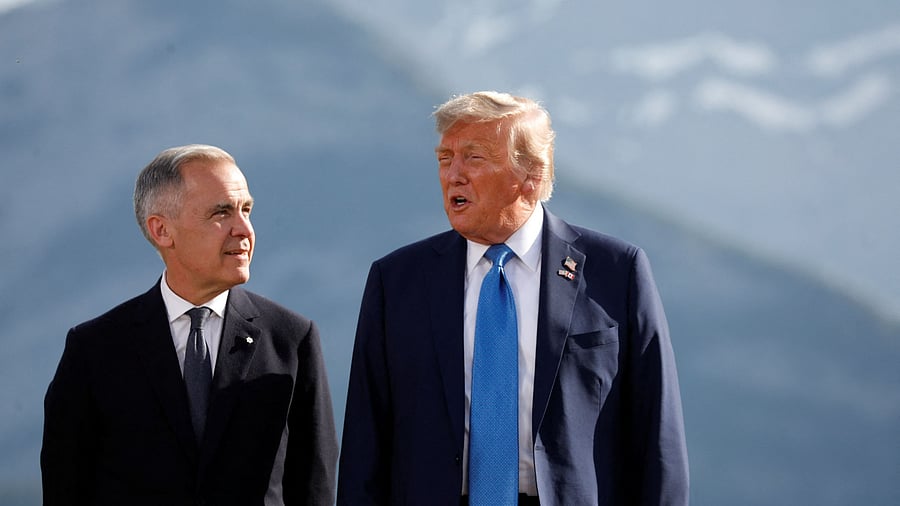
Canada Prime Minister Mark Carney and US President Donald Trump
Credit: Reuters Photo
It seems that nothing Canada has tried so far has shielded it from the threats of Donald Trump.
Barely a week after Trump and Prime Minister Mark Carney restarted trade talks, Trump published a new broadside against one of the US’s largest trading partners, threatening a 35% tariff.
The letter — which arrived during Carney’s vacation — reiterated Trump’s complaints about dairy quotas, fentanyl and the US trade deficit, which is mostly fueled by US refineries’ thirst for Canadian oil. His social media post caused the Canadian dollar to drop, indicating the market wasn’t expecting this escalation.
Trump’s missive deepens a political dilemma for Carney: How to respond to never-ending tariff threats from the White House while also protecting the country’s US-exposed economy.
The prime minister has mostly tried to cool tensions with Trump. He has tried flattery, too, calling Trump a “transformational president” during a visit to the White House in May.
Carney’s predecessor, Justin Trudeau, tried to appease the president, then fight him. His government announced major new spending on border staff and technology to address Trump’s concerns about migrants and fentanyl — even though US government data show that problems at the US-Canada border are minor compared to the frontier with Mexico.
Trump went ahead with tariffs anyway. So Trudeau retaliated. By the time he left office in the middle of March, Canada had placed 25% import taxes on tens of billions of dollars of US-made products — everything from steel and aluminum to fishing rods, garden tools and cosmetics.
Carney’s approach has been less combative, at least since the end of the Canadian election in April. He passed on the opportunity to retaliate against the US for higher steel and aluminum tariffs and carved out a number of exemptions to Trudeau’s counter-tariffs.
But hopes of progress were rattled in late June when Trump broke off talks, citing his opposition to Canada’s planned digital services tax, which would have hit US tech giants. Canada ditched the tax on June 29. It bought peace, but not for long.
Neither prime minister’s approach has spared Canada from a fate similar to Japan, South Korea, South Africa and other nations that have faced one tariff threat after another from Washington.
“There was hope that there was light at the end of the tunnel — unfortunately it appears that light is a train,” Karl Schamotta, chief market strategist at Corpay Inc., said by phone. “It does look as if negotiations between Trump and Canada and many other countries have essentially been irrelevant to the process.”
In a post on X late Thursday, Carney treated the Trump letter as simply a new date. “Throughout the current trade negotiations with the United States, the Canadian government has steadfastly defended our workers and businesses. We will continue to do so as we work towards the revised deadline of August 1,” he wrote.
Schamotta said Trump’s move adds to a chilling effect on the Canadian economy. “It is a reality check for all of those who hope that Carney being elected would simply open the door to US markets — that’s just not the case,” he said.
“Like most copy-and-paste chain-letters, this latest tariff threat from the US promises disaster if its warnings and predictions aren’t taken seriously,” Candace Laing, chief executive officer of the Canadian Chamber of Commerce, said in a statement. “But it’s the senselessness of this trade war that is the real tragedy.”
Political Dynamics
Carney was already under mounting pressure to fulfill his election pledge to stand up to Trump, while also trying to strike a deal with a volatile president whose country bought about 75% of Canada’s exports last year.
“In April, there were very complicated political dynamics: Carney won an election on an argument that tariff escalation was unifying,” said Oliver Lavelle, global macro strategist at Thiel Macro LLC.
David Eby, British Columbia’s premier, had a scathing response to Trump’s threats. “This letter is flailing and factually incorrect. Other F words come to mind,” he said in a social media post.
The office of Ontario Premier Doug Ford said in a statement the federal government should “work around the clock” to secure a deal that eliminates all tariffs.
The new 35% tariff suggested by Trump is an escalation from a previous 25% tariff that applies to goods not compliant with the US-Mexico-Canada trade agreement. USMCA-compliant goods will remain exempt from the new rate, a US official told Bloomberg News, though the situation remains fluid and things could change.
US trade data showed 58% of Canadian imports were USMCA-compliant in May, said Randall Bartlett, deputy chief economist with Desjardins Group. Companies stepped up compliance in the early stages of the trade war, but that’s since slowed. Trump’s latest salvo might reaccelerate that process, Bartlett said.
Equity strategists at Canadian Imperial Bank of Commerce estimated that between 10% and 15% of Canadian exports to the US would face the higher rate, if the US goes through with it.
With so many Canadian goods set to avoid the headline 35% tariff, Carney may want to avoid ratcheting things up with tit-for-tat counter-tariffs, Lavelle said.
“You have a situation where, unless this escalates dramatically, the actual effective tariff rate is actually fairly small, or at least smaller than someone might think initially.”
The situation “further resolves Canadian efforts to find new trading partners,” said Heather Exner-Pirot, senior fellow with the Macdonald-Laurier Institute. “We have a surplus of food, energy and critical minerals. We’re a reliable trading partner that doesn’t bring strings attached. We need to leverage our options.”